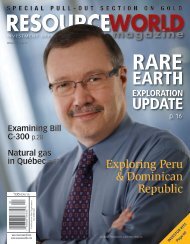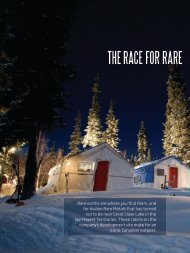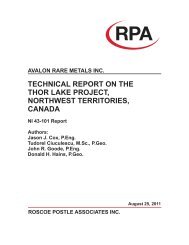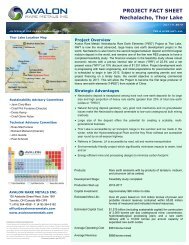technical report on the nechalacho deposit, thor lake project ...
technical report on the nechalacho deposit, thor lake project ...
technical report on the nechalacho deposit, thor lake project ...
Create successful ePaper yourself
Turn your PDF publications into a flip-book with our unique Google optimized e-Paper software.
The nepheline-sodalite syenite hosting <strong>the</strong> Nechalacho <strong>deposit</strong>, here termed <strong>the</strong> Nechalacho<br />
nepheline sodalite syenite, has <strong>the</strong> following key distinctive features which c<strong>on</strong>trast it to <strong>the</strong> Thor<br />
Lake Syenite and Grace Lake Granite:<br />
• It has a distinct chemical compositi<strong>on</strong> with under-saturati<strong>on</strong> in quartz as shown by <strong>the</strong><br />
presence of nepheline and sodalite as primary rock-forming minerals.<br />
• It displays cumulate layering.<br />
• It c<strong>on</strong>tains agpaitic zirc<strong>on</strong>-silicates (including eudialyte).<br />
• It is <strong>the</strong> host to <strong>the</strong> Nechalacho zirc<strong>on</strong>ium-niobium-tantalum-rare earth element<br />
mineralizati<strong>on</strong>.<br />
The Nechalacho Syenite is <strong>on</strong>ly exposed at surface in a small porti<strong>on</strong> of <strong>the</strong> Thor Lake Syenite<br />
between L<strong>on</strong>g and Thor Lakes. It is believed that <strong>the</strong> Nechalacho Syenite dips underneath <strong>the</strong><br />
Thor Lake syenite in all directi<strong>on</strong>s. This is supported by drilling north of Thor Lake, within and<br />
close to Cressy Lake. Also, <strong>the</strong> Nechalacho mineralizati<strong>on</strong> occurs in <strong>the</strong> top, or apex, of <strong>the</strong><br />
Nechalacho nepheline syenite.<br />
The Nechalacho nepheline sodalite syenite c<strong>on</strong>sists of a layered series of rocks with increasing<br />
peralkaline characteristics at depth. A c<strong>on</strong>sistent, downward progressi<strong>on</strong> is noted from <strong>the</strong><br />
hanging wall sodalite cumulates, through <strong>the</strong> coarse-grained or pegmatitic nepheline aegirine<br />
syenites (which are locally enriched in zirc<strong>on</strong>-silicates), to foyaitic syenite within a broad z<strong>on</strong>e of<br />
altered “pseudomorphs-after-eudialyte” cumulates (referred to as <strong>the</strong> Basal Z<strong>on</strong>e). This upper<br />
sequence is also intensely altered by various Na and Fe hydro<strong>the</strong>rmal fluids. Pre-existing<br />
zirc<strong>on</strong>-silicates are completely replaced by zirc<strong>on</strong>, allanite, bastnaesite, fergus<strong>on</strong>ite and o<strong>the</strong>r<br />
minerals. Beneath <strong>the</strong> Basal Z<strong>on</strong>e cumulates, mineralizati<strong>on</strong> decreases rapidly, but alterati<strong>on</strong><br />
decreases more gradually, with relict primary mineralogy and textures increasingly preserved.<br />
Aegirine and nepheline-bearing syenites and foyaitic syenites progress downward to sodalite<br />
foyaites and naujaite. Drilling has not extended bey<strong>on</strong>d this sodalite lithology to date. Minerals<br />
related to agpaitic magmatism identified from this lower unaltered sequence include eudialyte,<br />
catapleite, analcime, and possibly mosandrite.<br />
REGIONAL STRUCTURES<br />
The BLC was emplaced in a setting that was initially extensi<strong>on</strong>al with a triple juncti<strong>on</strong> rift<br />
c<strong>on</strong>sisting of structures oriented at azimuths of 060 to 070 degrees, 040 degrees, and 330<br />
degrees. These structures are readily seen <strong>on</strong> large-scale topographic and magnetic maps but<br />
<strong>the</strong>ir presence can be detected at <strong>the</strong> outcrop scale and within <strong>the</strong> distributi<strong>on</strong> of <strong>the</strong> structurally<br />
influenced mineralized z<strong>on</strong>es (R-, S-, and T-z<strong>on</strong>es). The 060 to 070 degrees and <strong>the</strong> 040<br />
degrees structures represent orientati<strong>on</strong>s of <strong>the</strong> failed “East Arm Aulacogen” now occupied by<br />
<strong>the</strong> Hearne Channel in <strong>the</strong> vicinity of <strong>the</strong> Nechalacho <strong>deposit</strong>. The presence of younger,<br />
Aphebian-age, metasedimentary and metavolcanic rocks of <strong>the</strong> Great Slave Supergroup to <strong>the</strong><br />
Technical Report 43-101 – March 13, 2011 Page 7-4<br />
Prepared by Aval<strong>on</strong> Rare Metals Inc.
















